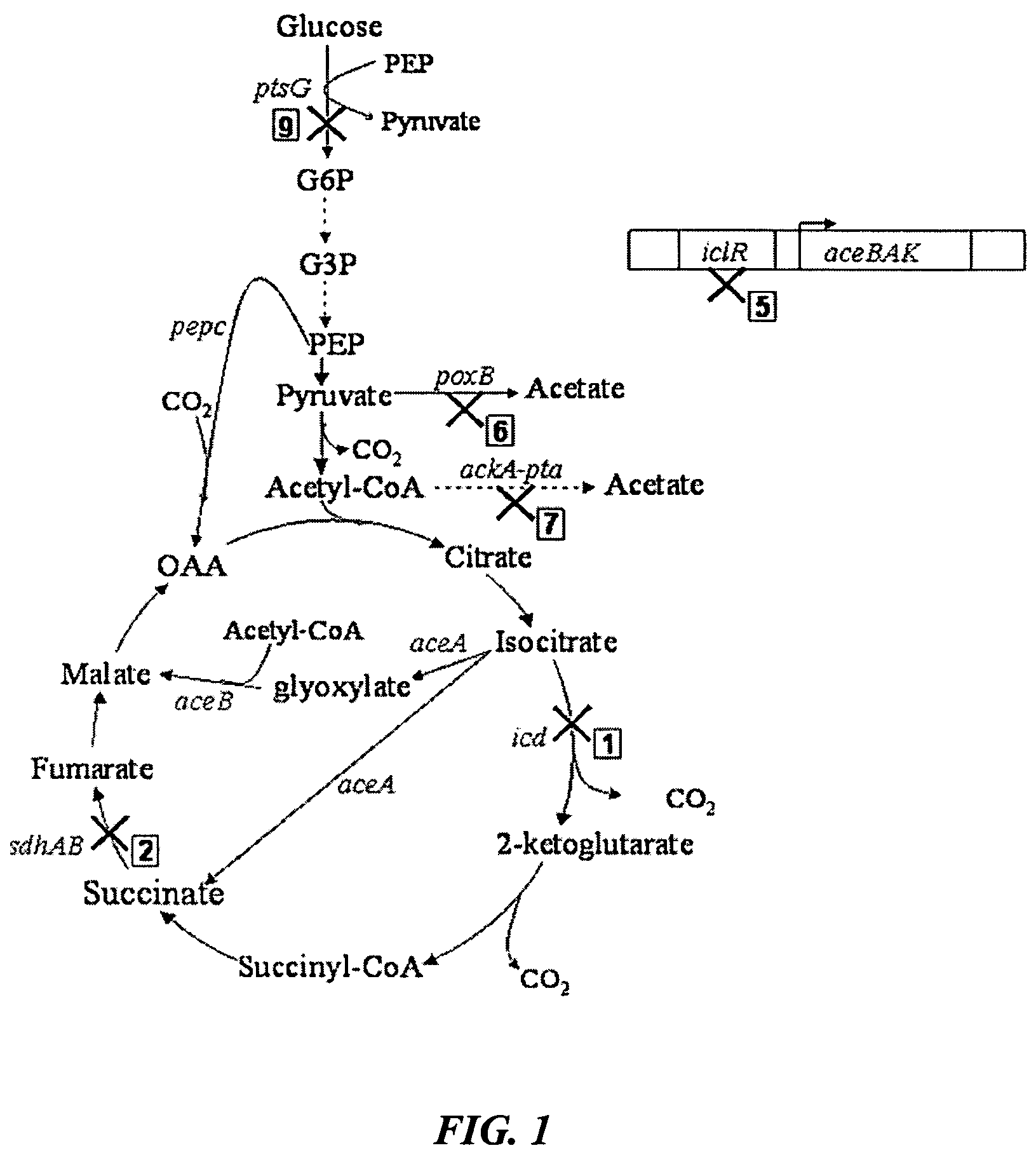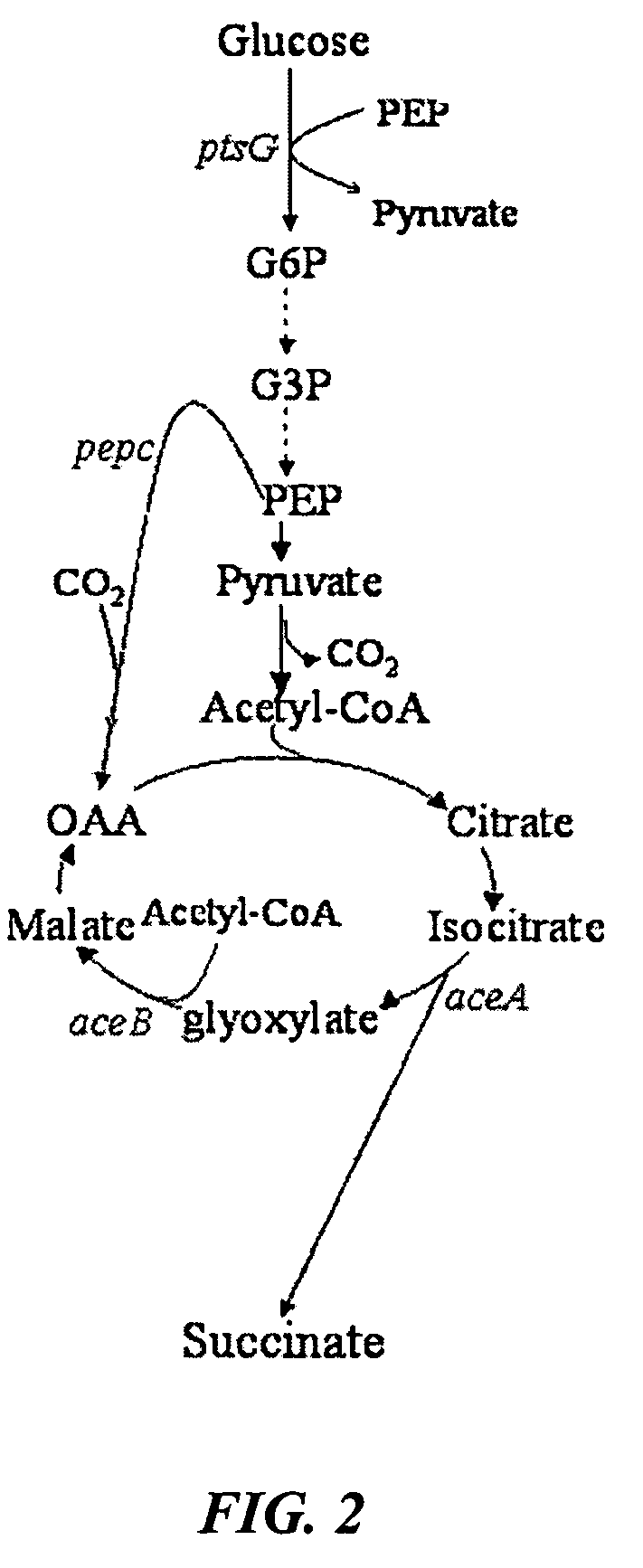Aerobic succinate production in bacteria
a technology of aerobic succinate and bacteria, applied in the field of aerobic succinate production in bacteria, can solve the problems of affecting the yield of desired products, large amount of growth substrates such as glucose, and inability to convert desired products to desired products,
- Summary
- Abstract
- Description
- Claims
- Application Information
AI Technical Summary
Benefits of technology
Problems solved by technology
Method used
Image
Examples
example 1
Plasmid Construction
[0050]Relevant plasmid constructs were transformed into various E. coli mutant strains to carry out certain exemplary embodiments of the invention.
[0051]The plasmids used in certain embodiments of the invention are set forth in Table 1 below. The mutant bacterial strains (untransformed and transformed) used in certain embodiments of the invention are set forth in Table 2 below.
[0052]
TABLE 1PlasmidPropertiespKK313S8D mutant Sorghum pepc, ApRpKK313CControl vector of pKK313 with inactive Sorghum pepc, ApR
[0053]
TABLE 2Recombinant StrainPropertiesGJT001Spontaneous cadR mutant ofMC4100(ATC35695)Δlac(arg-lac)U169rpsL150relA1ptsF SmRHL2kGJT001 Δ(sdhAB), KmRHL26kGJT001 Δ(sdhAB-poxB), KmRHL267kGJT001 Δ(sdhAB-poxB-ackA-pta), KmRHL2671kGJT001 Δ(sdhAB-poxB-ackA-pta-icd), KmRHL26715kGJT001 Δ(sdhAB-poxB-ackA-pta-icd-iclR),KmRHL27615kGJT001 Δ(sdhAB-ackA-pta-poxB-icd-iclR),KmRHL12675kGJT001 Δ(icd-sdhAB-poxB-ackA-pta-iclR),KmRHL51267kGJT001 Δ(iclR-icd-sdhAB-poxB-ackA-pta),KmRHL512...
example 2
Construction of Mutant Strains
[0054]Mutant strains derived from a parent E. coli strain, GJT001, were created by mutation of one or more of the genes encoding succinate dehydrogenase (sdh), pyruvate oxidase (poxB), acetate kinase-phosphotransacetylase (ackA-pta), isocitrate dehydrogenase (icd) and the aceBAK operon repressor (iclR), using the one-step inactivation method of Datsenko and Wanner (2000). This method first requires the construction of the single mutations using the phage λ Red recombinase. P1 phage transduction was then used to combine various mutations into one strain. Each mutation has to be added to the strain one at a time before the introduction of the next mutation because the kanamycin cassette has to be removed at each stage to enable selection of the next mutation.
[0055]PCR products of the kanamycin cassette gene flanked by FRT (FLP recognition target) sites and homologous sequences to the gene of interest were made using pKD4 as the template. These PCR product...
example 3
Growth of Mutant Strains
[0057]Aerobic batch reactor experiments were conducted for all the mutant strains. The medium used is LB with 2 g / L NaHCO3 and approximately 60 mM of glucose. The medium used for inoculum preparation is also LB, except glucose was not supplemented. NaHCO3 was added to the culture medium because it yielded better cell growth and succinate production due to its pH-buffering capacity and its ability to supply CO2. Kanamycin was added to the medium at a concentration of 50 mg / L for strains not harboring plasmids. In strains harboring pKK313 or pKK313C, ampicillin, carbenicillin, and oxacillin were added to the medium at a concentration of 200 mg / L each. Studies have shown that the use of methicillin and ampicillin is effective as a selective pressure in the cultivation of recombinant E. coli. Oxacillin is an analog of methicillin. The use of ampicillin, carbenicillin, and oxacillin in combination during the experiments enforced plasmid retention throughout the ae...
PUM
| Property | Measurement | Unit |
|---|---|---|
| concentration | aaaaa | aaaaa |
| concentration | aaaaa | aaaaa |
| volume | aaaaa | aaaaa |
Abstract
Description
Claims
Application Information
 Login to View More
Login to View More - R&D
- Intellectual Property
- Life Sciences
- Materials
- Tech Scout
- Unparalleled Data Quality
- Higher Quality Content
- 60% Fewer Hallucinations
Browse by: Latest US Patents, China's latest patents, Technical Efficacy Thesaurus, Application Domain, Technology Topic, Popular Technical Reports.
© 2025 PatSnap. All rights reserved.Legal|Privacy policy|Modern Slavery Act Transparency Statement|Sitemap|About US| Contact US: help@patsnap.com



